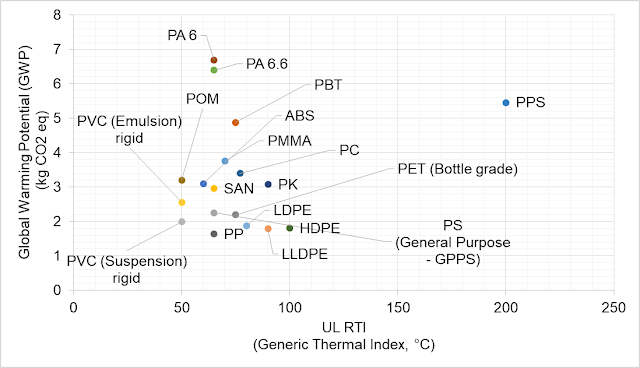Hello and welcome to a new post. Today we continue with the Global Warming Potential (GWP) of thermoplastics. In a previous post I presented the GWP of different plastics vs. their density. In this post I show the GWP values of thermoplastics compared to their different thermal properties and transitions: Tg, heat capacity (Cp), short term temperature exposure (HDT) and long term temperature exposure (UL Yellow Card). This allows for a better assessment of the different GWP values in relation to the resin properties.
Allover,
there are five major environmental indicators, which can have an impact on our
surroundings (check also my previous post on this topic):
-Global Warming Potential (GWP, 100 years)
-Ozone Depletion Potential (ODP)
-Acidification Potential (AP)
-Photochemical Ozone Creation Potential (POCP)
-Eutrophication Potential (EP)
In
addition, energy consumption, water footprint, dust/particulate matter and non-hazardous
/ hazardous matter can be considered too. Furthermore, it is important to
consider the whole lifetime of a plastic part and GWP will be one of the parts
supporting polymer material selection decisions.
 |
| GWP of thermoplastics vs. glass transition (Tg) |
 |
| GWP of thermoplastics vs. short-term temperature impact (HDT) |
 |
| GWP of thermoplastics vs. long-term temperature impact (UL RTI) |
 |
| GWP of thermoplastics vs. heat capacity (Cp) |
Thank you for reading and #findoutaboutplastics
Greetings,
Herwig
Interested to talk with me about your plastic selection, sustainability, and part design needs - here you can contact me
Literature:
[1] https://legacy.plasticseurope.org/en/resources/eco-profiles
[2] Korea LCI database;
[3] Ecoinvent database

No comments:
Post a Comment